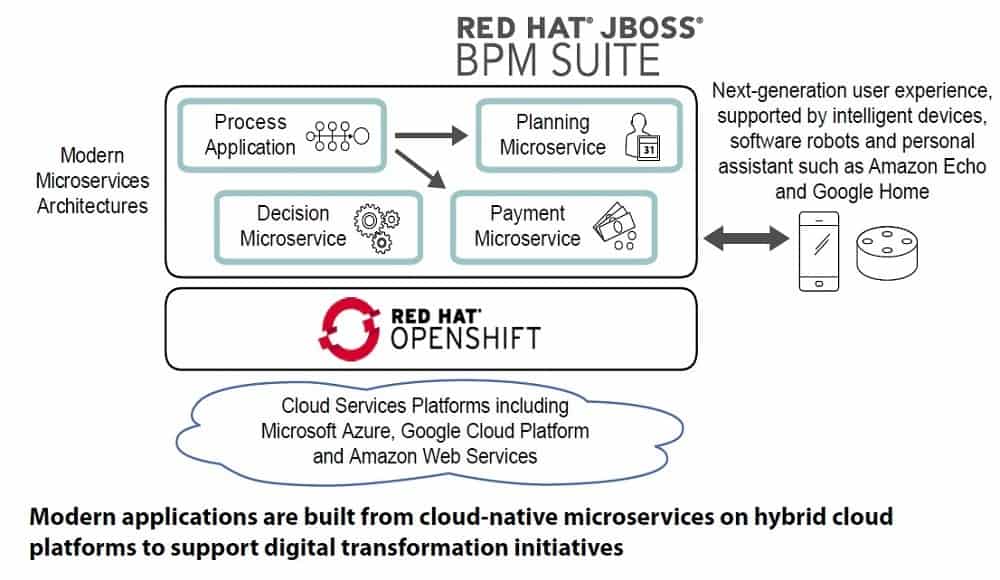
About 37 percent of most typical business processes have been digitized. Companies using BPM applications have seen significant benefits.
Today we are witnessing the greatest expansion of information technology into business processes ever seen. Entire new businesses – running solely on the cloud, employing data in new and ingenious ways – are disrupting the corporate world to the point where even the largest organizations are fearing for their relevance. Today’s consumers are digitally empowered, not only with devices, but also an abundance of online resources.
For startups, the equation is simple: devise a business model, surround it with relevant technology, and get the idea to market as quick as possible. If the business model or idea has flaws, adapt on the fly until it resonates.
For established enterprises, such unbridled innovation is not so easy. Organizations have invested years’ worth of staff time, budgets and other resources in existing systems and applications. The infrastructure supports business processes that are thoroughly embedded within the enterprise, and are often so intertwined with the technology they are frequently painful to revise or remove.
Is it even possible for an established company with so much technology baggage to be as agile and nimble as an unencumbered startup? The answer is yes – and this is the core of the movement toward digital transformation.
Even within moribund industries, there are leaders grasping the potential offered through technology modernization and moving ahead of their competitors. “Bold, tightly integrated digital strategies will be the biggest differentiator between companies that win and companies that don’t, and the biggest payouts will go to those that initiate digital disruptions,” according to McKinsey consultants Jacques Bughin, Laura LaBerge, and Anette Mellbye, reporting on a recent study of digital leaders. “Fast-followers with operational excellence and superior organizational health won’t be far behind.”
On average, about 37 percent of most typical business processes have been digitized, McKinsey reports – much of this the low-hanging fruit such as e-commerce channels. The heart of enterprises – for example, financials and supply chains – still are tied to legacy systems and processes. Business users need flexibility and capability to rapidly map available technology services, on demand, to pressing requirements. A new generation of business process management and business rules management tools and platforms is making this possible, in an agile and flexible way, and is compatible with all existing business environments.
What does a digital transformation look like? It varies from organization to organization, of course, since they have invested in countless systems and applications over the years. Digital transformation consists of building new applications and next-generation architectures on today’s open standards, using on-demand resources. For many organizations, digital transformation also means optimizing existing systems and application resources – integrating, replacing, or abstracting key pieces of their infrastructures into services.
The stage for enterprise digital transformation is being set from four directions.
- Application modernization: Bringing existing applications up-to-date, using cloud infrastructure, microservices and containers to abstract and service-enable existing applications.
- Cloud adoption: Building new apps natively on cloud-based systems.
- Agile integration: Connecting applications and organizations together for seamless interaction within and between enterprises.
- Designing or redesigning process-driven applications: Optimizing business process management and business rules management to rapidly map and deploy business technology services to ever-changing processes.
BPM Applications: Process-Driven Apps Fuel Digital Transformation
The ability to design or redesign process-driven applications represents the most expedient and effective way to successfully navigate the digital transformation journey. There is no such thing as a static business process. Processes evolve and change as rapidly as the business changes – meeting customer preferences, releasing new products, pivoting to new markets, and forging new partnerships. Today’s generation of business process management (BPM) and business rules management systems (BRMS) solutions, offers a way to rapidly build modern applications with a minimum drain on precious and expensive IT resources.
Here is how digital BPM and BRMS help enterprises in their digital transformation journeys:
- Orchestrate resources within the organization, routing work to the right people and applications, enabling collaboration.
- Automate routine manual tasks, reducing manual work, and decision management. Digital BPM and BRMS paves the way to robotic process automation, which is revolutionizing the handling of the countless routine and manual tasks that slow down productivity.
- Enable self-service, making it possible for business users to develop and maintain applications without going through IT departments. So, it doesn’t necessarily require hard-core coding skills.
Ultimately, the purpose and intent of digital transformation is to deliver value to the customer – quickly, with continuous delivery of quality and functionality. Digital business process management and business rules management systems is the keystone to this journey, enabling enterprises to rapidly deploy and configure business technology to ever-changing processes, when and where it is needed.
 Case Study: Healthesystems Modernizes Business Process and Rules Management
Case Study: Healthesystems Modernizes Business Process and Rules Management
Digital BPM and BRMS are enabling businesses to operate at real-time speeds, to keep up with even the most demanding environments. Healthesystems, a leading provider of workers’ compensation medical management solutions, implemented a business rules solution based on Red Hat JBoss BPM Suite to respond faster to changing regulations and customer needs.
The company’s challenge is that its operations were bogged down by compliance reporting, tied to a costly, complicated system that used complex reporting file formats. Healthesystems staff also had to manually fix missing or incorrect data within short resolution periods, while dealing with differing state government requirements.
The key was to automate these activities, and make it easy for non-technical staff to perform. “We had all those rules in code, so if a business analyst had to update a rule, they needed a developer to help,” said Sam Alexander, enterprise architect at Healthesystems.
The BRMS manages state reporting workflows at the medical code level. Rules can be applied based on the source code, and individual rules can be changed without affecting other rules. With Red Hat JBoss BPM Suite, business analysts can use a web-based decision table to input information. The company can now react more quickly to evolving state reporting regulations for workers’ compensation, as well as customer price margin changes. The new solution reduced the time needed for business processes, from system planning and design to mapping complex requirements into workflows and business rules. “We just go to the decision table, add the new customer and attributes, and we’re done. The customer pricing rules are applied. Testing is self-contained and easy,” said Alexander.
(Read the complete case study here.)
 Case Study: TMG Health Delivers Real-Time Services
Case Study: TMG Health Delivers Real-Time Services
Digital BPM and BRMS are also helping even the most legacy-laden organizations move into the digital economy. TMG Health, the largest business process outsourcing provider in the Medicare and Medicaid market, was able to move from slow, batch-oriented processes to real-time services to an open source, open-standards-based application platform using Red Hat JBoss Enterprise Application Platform and other Red Hat solutions.
“We needed to move from limited data visibility to real-time visibility,” said Nicolaas Botes, executive director of enterprise architecture for TMG.
The company’s data interactions and integration occurred from once daily in a batch feed to sometimes just once a month, but its clients wanted immediate, constant interaction to serve their own customers better. For example, the company needed to be able to provide information to pharmacies on out-of-pocket expenditure caps at the moment they are needed – when customers are placing their prescription orders.
Consolidating its systems on a single technology suite lets TMG develop applications that are easier to support, as well as automate. Patterning development lets developers focus less on integration and more on business logic. In addition, the company can employ metrics and data to serve clients more effectively. For example, TMG can guarantee response times by prioritizing requests from clients that purchase more bandwidth on its systems.
TMG was one of the first in the BPO industry to be able to offer advanced services such as real-time enrollment to its customers, which help create new revenue sources that will potentially increase its market reach by 50 percent. “Our clients can now access their data at any given point,” said Botes. “In the BPO industry, the more visibility you can give your clients, the happier and more productive they are.”
(Read the complete case study here.)
 Case Study: Railinc Updates Apps Immediately Based on Customer Feedback
Case Study: Railinc Updates Apps Immediately Based on Customer Feedback
The ability to create rules and models for business processes within a digital framework is an essential component of the digital enterprise. Railinc, the leading information technology services provider to the railroad industry, recently enhanced its ability to deliver real-time services to its customers employing digital BPM and BRMS capabilities. This was part of the company’s Rules and Process Modernization (RPM) program, a five-year, enterprise-wide effort, with Red Hat JBoss BPM Suite, to modernize business rules and process management for the company’s applications and systems.
The complexity of managing the business rules and processes that support Railinc’s applications reduced the company’s agility and increased response times to customer requests. The company helps manage the proper movement, interchange, monitoring, and repair of more than 1.5 million railcars across a 217,000-mile rail network. The business logic – often expressed as rules and processes – has traditionally been buried in code in Railinc’s applications, making it difficult to respond quickly to customer questions or requests, update applications, or share knowledge across the company.
With its new open source-based digital BPM environment, the company provides greater visibility into applications, enabling developers, business analysts, product support specialists, and others to quickly correct issues and make changes to incorporate industry rules and better align product functionality with rail operations. Railinc can now extract business rules and processes from application code and rewrite them in plain English to provide developers and business analysts with documented rules and processes they can use to respond to customer requests and make application updates faster. At full maturity, product and customer support teams will be able to update applications immediately based on customer feedback.
“Extracting the business rules and processes makes it easier and faster to update applications in response to customer feedback,” said Jerry Vaughn, director of interline services and chair of Railinc’s RPM program steering committee. “It also empowers a broader group of employees to quickly make changes to applications and improve the customer experience.”
(Read the complete case study here.)
 Case Study: SIA Improves Speed with Digital BPM
Case Study: SIA Improves Speed with Digital BPM
SIA, a payments solutions provider, has been able to ramp up its market share by moving to an open software platform built on top of its existing infrastructure. The company developed an automated, flexible prebilling system to collect data from various legacy systems and apply business rules to calculate client bills. The company moved its legacy systems to open source, including more than 100 mechanisms for collecting and storing billing data.
The company deployed Red Hat JBoss Fuse to collect and store transaction data, implemented Red Hat JBoss BPM Suite to manage business rules and related governance workflows, and migrated to a web application that uses Red Hat JBoss EAP for custom user interfaces to manage rule editing and versioning.
The company has seen improved costs and efficiency by moving rules management from developers to business units, and reduced development time for prebilling data streams from new and existing services.
(Read the complete case study here.)
Enablers of Digital Transformation
There’s no getting around that digital transformation can be a complex or expensive process, especially when it comes to harnessing organizational and cultural forces to set businesses on a digital path. The tools and technologies, however, are ready and available. Every organization now has access to modern, cloud-friendly software that meets business needs to engage with customers, respond quickly to changes, and achieve greater innovation.
Digital transformation isn’t dependent on one type of technology or one type of approach. Rather, it is based on a constellation of solutions and methodologies that are enabling enterprises to more effectively and expeditiously develop and deploy new approaches.
Digital technologies and platforms that help to dramatically speed up, simplify and empower application development include the following:
- Private and public cloud services offer both development tools and environments that provide the latest tools and methodologies to development teams.
- Microservices and containers provide deployment and operations teams the means to quickly place and launch essential applications when are where they are needed.
- Artificial intelligence/machine learning/cognitive computing provide systems the ability to automate and update decisions based on continuous evaluation of incoming data.
- Internet of Things/connected, ambient computing enable businesses to sense and respond to events and information about their environments and even how products are being used.
- Data analytics provides insights to decision makers and applications based on data coming in from across their enterprises and beyond.
- Robotic process automation enables the automation of routine manual tasks.
- DevOps and Agile development open up business technology development and deployment to iterative spurts tied to the pressing and ever-changing needs of the business.
- Open source solutions and communities offer prebuilt solutions based on open standards that can quickly and cost-effectively be plugged into existing systems and processes.
- Business process management and business rules management systems enable decision makers to assemble, on demand, applications that drive business processes.

































